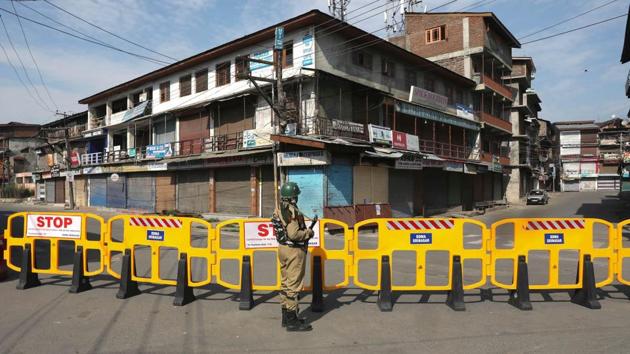J&K: A year of hope and despair | Analysis
Compensate citizens for economic loss; restore statehood; allow 4G services; release prisoners
The creation of the state of Jammu and Kashmir by my ancestor Maharaja Gulab Singh in 1846 was a significant geopolitical event in the subcontinent. It resulted in the extension and consolidation of the northern borders of India all the way up to Central Asia (Gilgit-Baltistan) and Tibet (Ladakh). These Dogra campaigns involved the heavy sacrifice of lives but finally resulted in the creation of the Jammu and Kashmir (J&K), the largest princely state in India. This multi-regional, multilinguistic, multi-religious and multicultural state finally disappeared a year ago.

It is important to understand that J&K was a unique state which encompassed far-flung areas that had not previously been administered by India. The end of the state a year ago, therefore, had significant geopolitical implications. These involve Gilgit-Baltistan, which we lost in 1947 along with Pakistan-occupied J&K as well as Aksai Chin, which we lost in 1952, and the Saksham valley, which has been handed over to China by Pakistan. Although these areas were not after 1947 under Indian administration, the dismantling of the state into two Union Territories (UTs) seems to have disturbed both our neighbours.
Internally, while the Ladakhis welcomed the realisation of their long-standing desire to become a UT, the response in J&K was very different. For Kashmiris, who took pride in their special status, and were pressing for more autonomy and nursing unrealistic expectations, to have not only lost that status but also been reduced to a UT and virtually locked down for almost a whole year along with the closure of educational institutions has been traumatic. In Jammu, the move was generally welcomed as it was around the country. To be fair, this policy had been on the Bharatiya Janata Party (BJP)’s agenda for many years, though no one expected the dramatic manner in which it was implemented.
The restoration of full statehood for J&K is a demand from both the regions. There is no reason why the erstwhile state should be demoted to the category of a UT, which is looked upon as a humiliation. The restoration should also involve a structure that ensures for the first time a fair distribution of political, financial and administrative authority between the J&K regions. The expensive and obsolete darbar move can be dispensed with, and a new structure put in place that ensures undisturbed year-round administration to both the regions. Domiciliary provisions for safeguarding public appointments and purchase of land by non-residents should be adopted on the same lines as in the hill states of Himachal Pradesh and Uttarakhand.
The restructuring promised enhanced economic development to both regions and has raised high expectations. But the state and its people have suffered massive financial losses over the last year. Tourism, which is the mainstay of the Kashmiri economy, has totally collapsed as a result of which thousands of people involved in the tourism trade have been rendered unemployed. Horticulture has also suffered and there has been a sharp drop in the export of apples from the Valley. The cancellation of the Amarnath Yatra in Kashmir and the Mata Vaishno Devi Yatra in Jammu has also caused extensive unemployment and commercial losses. The first task before the government, which is now directly administering the state, therefore, must be to compensate for these massive losses without delay. It is only once the financial distress has been contained that economic development can begin and investors will feel secure enough to start putting money into new projects. Ladakh has also been badly hit by the drop in tourism. The disturbing influx of Chinese troops, which has been pushed back by our security forces, continues to be a source of deep national concern, especially to the people of Ladakh. While the official claim is that militancy has decreased over the last year, militant attacks still occur from time to time.
However, we must now look realistically to the future. The first requirement is the resumption of normal political activity. This will necessarily involve a fresh unbiased delimitation based on the 2011 Census, followed by elections to the state assembly as may be decided by the Election Commission. The delimitation should include allotting additional seats due to the hundreds of thousands of refugees in the Jammu region who remained disenfranchised. It is also necessary for political parties to start functioning again. The BJP is already active, but the Congress must get its act together. The two main regional parties — the National Congress and the Peoples Democratic Party — would be well advised to restart political activities in light of the new realities. Some recent statements seem to indicate that mature elements are beginning to come to terms with the changed situation. In this context, the restoration of full Internet services, which the Supreme Court itself has favoured, will be an important step towards normalisation, as will be the release of political prisoners.
A year later, the disappearance of J&K and its replacement by two Union territories presents a mixed picture of hope and despair, expectation and disappointment. Prime Minister Narendra Modi has often reiterated his determination to further the welfare of the people of the erstwhile state. He and the home minister must now personally ensure that this is achieved.
The state administration needs to be far more proactive than it is, and once the political process starts, we hope to see the situation return to fresh stability. Then, the people of the erstwhile state can finally embark on a new chapter of welfare and all-round development.



